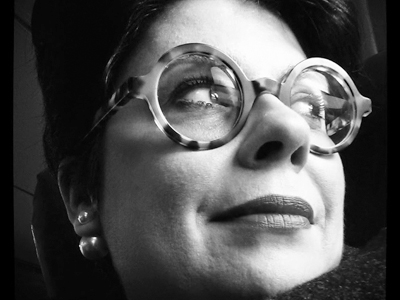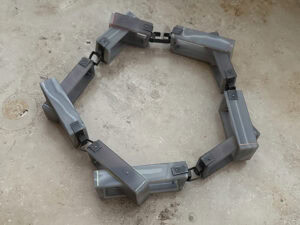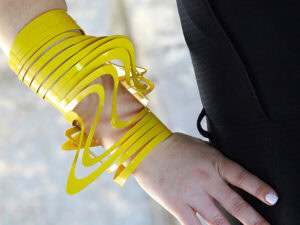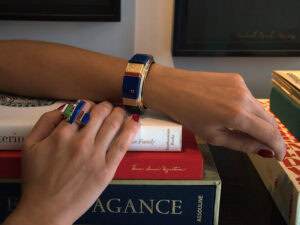Art history is a long road where precocities and delays often collide; it’s made of screams and terrible silences. As Henri Focillon wrote once, “[a work of art] is both completely absorbed in the dynamism of time and, at the same time, a universal witness”[1]: forms live through time and space, and history of the arts testifies to their lives. This One on Two article will try to delineate how circular layered forms are expressed and rendered by the artists Karen Margolis and Susie Ganch.
Karen Margolis uses Enso (“circle” in Japanese) as her main source of inspiration: fascinated both by the sense of perfection and its opposite, she has adopted circles as a form for investigating the links between the known, measured spaces of maps and the infinite, indeterminate territories emerging from drilling through and layering those maps.

Her work Zaohua is part of her Map series: the artist says that “Maps offer the implicit promise of directions”[2]but they can also become obsolete over time. And so she “operates” on old maps, making holes and revitalizing them by composing them in layers. Directions change, and those mapped territories—once well known—are now completely subverted and recomposed, providing new spaces and giving birth to different, wide areas that contain emptiness.
Susie Ganch, meanwhile, is “driven by the idea the web of life is an interconnected-system”[3]: her brooch, part of her Dust series, is made of multi-layered circular forms. Once you look at her piece, a sense of tension emerges: each element is independent but connected to the others. “From a distance some of my work looks solid while some disappears. Up close, however, the grid structure and ‘molecules’ are see-through and multi-layered.”[4]Her work is like a territory in expansion, made of molecular pieces in perfect balance, turned outward. All of the brooch’s constituents are connected to one another, forming a Democritean substrate—a base formed by interconnected atoms—in constant expansion.

Comparing the two works suggests to me that both artists deal with the search for endless spaces and the infinite: in this constant exploration of new areas to discover, Karen Margolis drills her maps to suggest a form of implosion, whereas Susie Ganch conceives her brooch with a number of tiny structures opened to the external world blowing outside.
I am fascinated by the notion of drilling maps, as done by Margolis: what starts from a well-known geography—because this is the true nature of a map—becomes a new journey and an investigation on emptiness, as well as on the infinite. Holes, understood as wide and unknown spaces that cannot be mapped, are ascribed exact coordinates by the map itself, suggesting a form of inner implosion. In contrast, the work of Ganch explodes and articulates its own little structures, amplifying the idea of molecular world in which it has been conceived. A small cell enlarged to infinity.
Both works, albeit on different scales, are in constant search of space; their movements of implosion and explosion evoke the alternation of breath, a balance between inhalation and exhalation, an eternal cyclic rhythm.
To conclude, I ask you kindly to allow me a capriccio, an invention: I would dare the comparison of these two works with the “Brandenburg Concerto No. 1 in F major BWV 1047,” by Johann Sebastian Bach.
The “Concerto n.1, BWV 1047” is composed as follows:
1. Allegro or Allegro moderato (usually performed), even if there’s no indication about the performing tempo;
2. Adagio;
3. Allegro;
4. Menuet—Trio I—Menuet again—Polacca—Menuet again—Trio II—Menuet again.
The instrumentation is structured with two hunting horns (natural horns), three oboes, bassoon, one violino piccolo (small violin), two violins, viola, cello, and basso continuo. My gamble hinges not only in the choice of the instrumental section, but especially in the structure of the concert that, unlike the other five compositions, numbers four movements instead of the usual three. The last movement is as a sort of suite, in a succession of dance movements that critics and historians identify as a kind of double concert given by the presence of violino piccolo, which completely modifies the structure of the baroque concert.
Listening to the concert, whose magnificent alternation of light and shadowed movements is provided by horns and strings, I always had the feeling of a succession of breaths or, if you prefer, an intermittence between full and wide spaces: the same spaces investigated by the two authors in circular form.
[1] Henri Focillon, Vie de Formes Suivi de Éloge de la Main (Paris: PUF, 1943; Italian translation Vita delle Forme Seguito da Elogio della Mano, Turin, Italy: Einaudi, 1972), 3.
[2] Karen Margolis, as quoted on her website, http://karenmargolisart.com/Karen/Maps.html#19.
[3] Susie Ganch, as quoted on her website, http://susieganch.com/section/341691_Dust.html.
[4] Susie Ganch, as quoted on her website, http://susieganch.com/section/341691_Dust.html.




